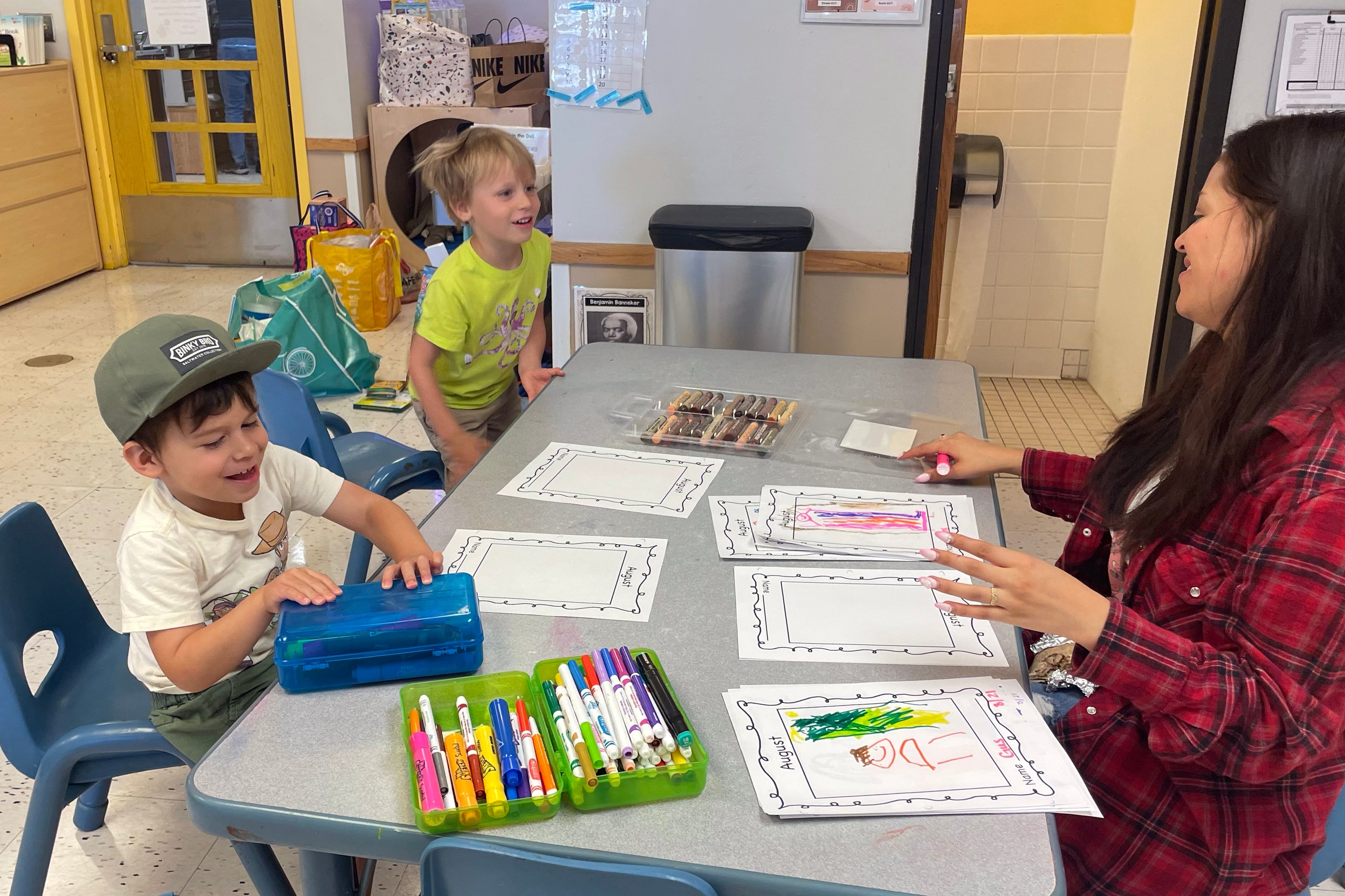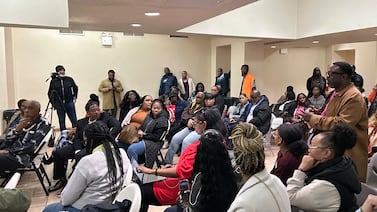Note: This story is about the 2024 free preschool application. For information about the 2025 free preschool application, read our updated story.
Colorado families can start applying for the state’s free preschool program for the 2024-25 school year on Feb. 29.
The $322 million program, which launched in August, is open to all 4-year-olds and some 3-year-olds. More than 39,000 4-year-olds are currently enrolled in the program — about 62% of that age group in the state. About 10,000 3-year-olds are also enrolled.
After a chaotic and confusing application rollout last spring and summer, state officials made several changes to this year’s process. The goal is to make it easier for families already connected to a preschool to stay with that program for universal preschool. The state also is making a change to ensure that children in poverty get access to full-day tuition-free preschool.
Here’s what families need to know about the preschool program and the online application.
Who gets free preschool and how much do they get?
Two groups of children qualify: All 4-year-olds and some 3-year-olds who need extra help.
The preschool program is primarily designed for children in the year before they go to kindergarten — children who turn 4 before the state’s Oct. 1 cutoff date. Most 4-year-olds will get 15 hours of preschool a week, though some preschool providers offer only 10 hour-a-week schedules.
Starting this year, 4-year-olds from families with incomes at or below 100% of the federal poverty level — up to $31,200 for a family of four — will qualify for 30 hours of tuition-free preschool a week.
In addition, 4-year-olds in families with income between 100% and 270% of the federal poverty level — $31,200 to $84,240 for a family of four — who also fall into at least one of the categories below qualify for 30 hours a week:
- Speak a language other than English at home.
- Have a special education plan, also known as an IEP.
- Homeless
- In foster care
Remember, not every preschool offers a 30-hour a week schedule — or if they do, has open seats available. That means qualifying for 30 hours of free preschool through the state isn’t a guarantee that a child will get it.
Compared to 4-year-olds, only a small number of 3-year-olds — children two years away from kindergarten — qualify for tuition-free preschool. This year, about one-third of 3-year-olds in universal preschool are children with disabilities and the rest are from low-income families or have other risk factors.
Only 3-year-olds who have special education plans are guaranteed free preschool. The number of hours depends on what’s spelled out in their special education plan. Parents of these 3-year-olds should fill out the state’s online application.
If there’s enough funding, 3-year-olds with one of the other risk factors listed above may get at least 10 hours of free preschool a week. Parents of these children can skip the state application and apply for free preschool directly through their local school districts.
What about 5-year-olds who aren’t in kindergarten yet?
A small number of 5-year-olds are eligible for free preschool in the year before they attend kindergarten. Specifically: Those living in school districts with kindergarten cut-off dates earlier than the state’s Oct. 1 cut-off whose birthdays fall between the two cut-off dates. For example, a child in a district where children must turn 5 by July 30 to attend kindergarten, will qualify for free preschool if they turn 5 in August or September.
Five-year-olds who could go to kindergarten but have been held out by their families — a practice often called redshirting — aren’t eligible for free preschool in that year.
When can I fill out the universal preschool application?
This year’s application will open on Feb. 29, about a month later than last year.
Starting then, certain families will get to preregister, specifically those who want to send their child to the preschool where the child is currently enrolled, where a sibling is enrolled, or where the parent is employed. These families will get an email from the state that links to a universal preschool application preloaded with their current preschool. Once the family accepts the placement, the match will be confirmed immediately.
To ensure you get a preregistration link, talk to your current preschool or child care provider about your plans to stay with the program for universal preschool. The provider will then let the state know about all continuing families.
Families not eligible to preregister can still fill out the universal preschool application starting on Feb. 29 but they won’t be matched to a preschool until April. Families who apply after that will get their preschool matches in June.
Starting in late June, walk-ins will be allowed. That means families can apply for universal preschool by calling or visiting a local preschool directly. If that preschool is participating in the state program and has space, staff there will help families apply and secure a spot.
Unlike last year, some parents of 3-year-olds can skip the state’s online application and apply for preschool directly through their school districts. This includes parents of 3-year-olds from low-income households, or who are learning English, are homeless, or in foster care. Parents of 3-year-olds with special education plans still have to apply using the state’s online application.
What do I need to fill out the application? Are there income requirements?
If you qualify for preregistration, you’ll receive a link from the state with a prepopulated application. If not, you’ll create your online application using an email address or phone number. Most families will need about 15 minutes to fill it out. The application is offered in English, Spanish, and Arabic.
Families with incomes at or below 270% of the federal poverty line will need to upload proof of income, such as pay stubs or tax forms, when they apply for universal preschool.
My child has a disability. What’s the application process?
Families will get a link from the state with a preloaded universal preschool application if their child will be 3 or 4 next school year, has a special education plan — also known as an IEP — and are already getting services for their disability through their local school district.
If the family of a child with a special education plan is not currently connected to their local district — perhaps they recently moved — they can fill out the universal preschool application when it opens. Once they indicate on the application that their child has an IEP, the district will reach out to them about next steps. Most preschoolers with IEPs will be placed in classrooms run by their school districts.
Parents who are worried their preschooler may be delayed in speech, learning, or development but don’t have a diagnosis or IEP, should contact Child Find, a state program that screens children suspected of having a disability. Check this list for Child Find coordinators by region.
Can I pick my 4-year-old’s preschool?
Yes. Families who don’t qualify for preregistration or want a program other than the one their child currently attends will be asked to pick up to five preschools and will be able to rank their choices. Options include school-based preschools, faith-based preschools, preschool programs inside child care centers, and state-licensed home-based programs.
Search and map functions are available within the universal preschool application to narrow down the choices. There are some cases where preschool providers can turn down a universal preschool applicant. For example, a school-based preschool might turn away a child who lives outside district boundaries or an employer-based preschool that mainly provides care to children of company employees may decline a child of a non-employee.
Can I pick my 3-year-old’s preschool?
Possibly, but you won’t have as many choices as 4-year-olds do. It all depends on your school district since districts are in charge of placing 3-year-old preschoolers. Some districts primarily serve 3-year-olds in district-run classrooms while others work with community child care programs to serve 3-year-olds. When you fill out the universal preschool application, you’ll select your school district and then work with them on preschool placement.
My district’s school choice application is due before the universal preschool application opens. What should I do?
Families who want to send their child to a district-run preschool run may have to fill out two applications. First up is the district’s school choice form. Next, fill out the universal preschool application when it opens.
If your child or a sibling already attends your favored district-run preschool, or you work there, the state will send you a preregistration link to a universal preschool application preloaded with your preschool choice in late February.
If you have no current affiliation with a district-run preschool, the state will send you a link to the general universal preschool application using your contact information from the school choice form. Fill out the application and choose your top five preschools and you’ll find out your child’s preschool match in April.
What if I need more hours than what my preschooler is eligible for?
You can still pay for extra hours above and beyond what the state covers for free, as long as the preschool offers more hours. You can also see if you qualify for financial help through other means, such as the state’s child care subsidy program or a local tuition assistance program. Here’s a rundown of the options.
I have more questions. What should I do?
Contact the local group that’s coordinating the universal preschool program in your county or region. Here’s a county-by-county list of all the groups — the state calls them Local Coordinating Organizations or LCOs — with email addresses.
You can also contact the state’s help desk from 7 a.m. to 10 p.m. Monday through Friday, excluding state holidays. The number is 303-866-5223 and the email is cdec_upkcolorado@state.co.us.
Do you have a question you don’t see answered here or can’t find the answer to elsewhere? Let us know at co.tips@chalkbeat.org and we’ll do our best to find an answer.
Ann Schimke is a senior reporter at Chalkbeat, covering early childhood issues. Contact Ann at aschimke@chalkbeat.org.







